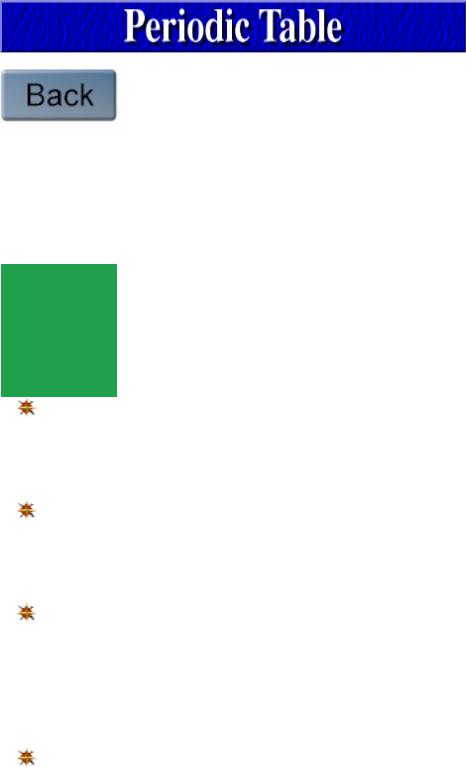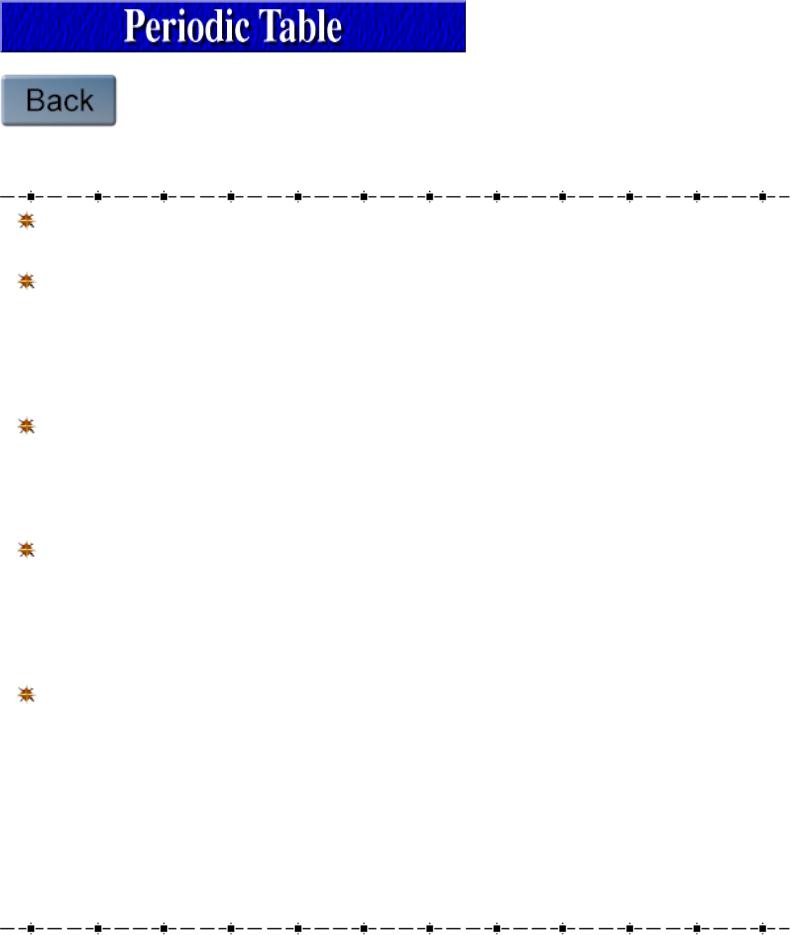
- •A Periodic Table of the Elements at Los Alamos National Laboratory
- •Hydrogen
- •Helium
- •Lithium
- •Beryllium
- •Boron
- •Carbon
- •Nitrogen
- •Oxygen
- •Fluorine
- •Neon
- •Sodium
- •Magnesium
- •Aluminum
- •Silicon
- •Phosphorus
- •Sulfur
- •Chlorine
- •Argon
- •Potassium
- •Calcium
- •Scandium
- •Tungsten
- •Zinc
- •Zirconium
- •Iron
- •Manganese
- •Antimony
- •Copper
- •Silver
- •Nickel
- •Chromium
- •Vanadium
- •Yttrium
- •Titanium
- •Molybdenum
- •Common Isotopes
- •Mercury
- •Cobalt
- •Lead
- •Gallium
- •Cesium
- •Rubidium
- •Germanium
- •Arsenic
- •Selenium
- •Bromine
- •Krypton
- •Strontium
- •Niobium
- •Technetium
- •Ruthenium
- •Rhodium
- •Palladium
- •Cadmium
- •Indium
- •Tellurium
- •Iodine
- •Xenon
- •Barium
- •Lanthanum
- •Hafnium
- •Tantalum
- •Rhenium
- •Platinum
- •Iridium
- •Osmium
- •Gold
- •Thallium
- •Bismuth
- •Polonium
- •Astatine
- •Radon
- •Francium
- •Radium
- •Actinium
- •Rutherfordium
- •Hahnium
- •Seaborgium
- •Nobelium
- •Neilsborium
- •Hassium
- •Meitnerium
- •Element 110
- •Element 111
- •Element 112
- •Mysterious Elements 114, 116, & 118
- •Cerium
- •Thorium
- •Europium
- •Praseodymium
- •Neodymium
- •Promethium
- •Samarium
- •Gadolinium
- •Terbium
- •Dysprosium
- •Holmium
- •Erbium
- •Thulium
- •Ytterbium
- •Lutetium
- •Protactinium
- •Uranium
- •Neptunium
- •Plutonium
- •Americium
- •Curium
- •Berkelium
- •Californium
- •Einsteinium
- •Fermium
- •Mendelevium
- •Lawrencium
- •Element Listing
- •Tell us or ask us
- •What is the Periodic Table?
- •How to Use the Periodic Table
- •Nutshell Chemistry
- •Mendeleev's Table
- •PERIODIC TABLE OF THE ELEMENTS

How to Use the Periodic Table
How to use the Periodic Table
When you open any file of an element in the periodic table, you will find a small table with some basic information about that element. Here's how you use that table:
5
B
Atomic
Number
Atomic
Symbol
10.81 Atomic Mass
Atomic Number
The number of protons in an atom defines what element it is. For example carbon atoms have six protons, hydrogen atoms have one, and oxygen atoms have eight. The number of protons in an atom is referred to as the atomic number of that element. The number of
protons in an atom also determines the chemical behavior of the element.
Atomic Symbol:
The atomic symbol is one or two letters chosen to represent an element ("H" for "hydrogen," etc.). These symbols are used internationally. Typically, a symbol is the truncated name of the element or the truncated Latin name of the element. Click here for
a list of the elements and their symbols.
Atomic Mass:
The atomic mass is the average mass of an element in atomic mass units ("amu"). Though individual atoms always have an integer number of amus, the atomic mass on the periodic table is stated as a decimal number because it is an average of the various isotopes of an element. Isotopes can have a weight either more or less than the average. The average number of neutrons for an element can be found by subtracting the number
of protons (atomic number) from the atomic mass.
Electron Configuration:
The electron configuration is the orbital description of the locations of the electrons in an unexcited atom. Using principles of physics, chemists can predict how atoms will react based upon the electron configuration. They can predict properties such as stability, boiling point, and conductivity. Typically, only the outermost electron shells matter in chemistry, so we truncate the inner electron shell notation by replacing the long-hand orbital description with the symbol for a noble gas in brackets. This method of notation vastly simplifies the description for large molecules.
Example: The electron configuration for Be is 1s22s,2 but we write [He]2s2 where [He] is equivalent to all the electron orbitals in the helium atom. The Letters, s, p, d, and f designate the shape of the orbitals and the superscript gives the number of electrons in that orbital.
http://pearl1.lanl.gov/periodic/use.html (1 of 2) [3/6/2001 8:38:26 AM]

How to Use the Periodic Table
Further explanation of the atom may be found Here.
L O S A L A M O S N A T I O N A L L A B O R A T O R Y
Operated by the University of California for the US Department of Energy
LANL External View | www@lanl.gov | Help | Copyright © UC 1999 | Disclaimer
http://pearl1.lanl.gov/periodic/use.html (2 of 2) [3/6/2001 8:38:26 AM]

Nutshell Chemistry
Chemistry in a Nutshell
The Atom
All macroscopic matter is made out of many tiny particles called atoms. The study of
how these atoms interact is called Chemistry.
Subatomic Particles
The three particles that make up atoms are protons, neutrons, and electrons. Protons and neutrons are heavier than electrons and reside in the "nucleus," which is the center of the atom. Protons have a positive electrical charge, and neutrons have no electrical charge. Electrons are extremely lightweight and are negatively charged. They exist in a cloud that surrounds the atom. The electron cloud has a radius 10,000 times greater than
the nucleus.
The Nucleus
The nucleus of an atom is made up of protons and neutrons in a cluster. Virtually all the mass of the atom resides in the nucleus. The nucleus is held together by the tight pull of what is known to chemists and physicists as the "strong force." This force between the protons and neutrons overcomes the repulsive electrical force that would,
according to the rules of electricity, push the protons apart otherwise.
Electrons
The electron is the lightweight particle that "orbits" outside of the atomic nucleus. Chemical bonding is essentially the interaction of electrons from one atom with the electrons of another atom. The magnitude of the charge on an electron is equal to the charge on a proton. Electrons surround the atom in pathways called orbitals. The inner orbitals surrounding the atom are spherical but the outer orbitals are much more
complicated.
Chemical Bonding
Chemically bonding occurs when two particles can exchange or combine their outer electrons in such a way that is energetically favorable. An energetically favorable state can be seen as analogous to the way a dropped rock has a natural tendency to fall to the floor. When two atoms are close to each other and their electrons are of the correct type, it is more energetically favorable for them to come together and share electrons (become "bonded") than it is for them to exist as individual, separate atoms. When the bond occurs, the atoms become a compound. Like the rock falling to the floor, they "fall" together naturally.
L O S A L A M O S N A T I O N A L L A B O R A T O R Y
http://pearl1.lanl.gov/periodic/nutshell.html (1 of 2) [3/6/2001 8:38:26 AM]
Nutshell Chemistry
Operated by the University of California for the US Department of Energy
LANL External View | www@lanl.gov | Help | Copyright © UC 1999 | Disclaimer
http://pearl1.lanl.gov/periodic/nutshell.html (2 of 2) [3/6/2001 8:38:26 AM]
